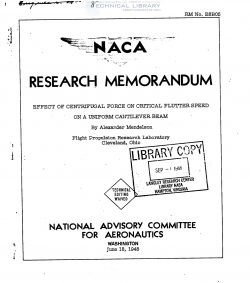naca-rm-e8b05
- Version
- 92 Downloads
- 568.68 KB File Size
- 1 File Count
- April 21, 2017 Create Date
- April 21, 2017 Last Updated
National Advisory Committee for Aeronautics, Research Memorandum - Effect of Centrifugal Force on Critical Flutter Speed on a Uniform Cantilever Beam

Theoretical calculations were made by means of semirigid-flutter
theory to determine the effect of centrifugal force on the critical
flutter speed of a uniform cantilever beam. Centrifugal force can
under certain conditions be detrimental, decreasing the critical
flutter speed. The higher the ratio of natural torsional frequency
to natural bending frequency the greater the decrease in critical
flutter speed due to centrifugal effect. The conclusion is drawn
that compressor and turbine blades that are flutter-free at zero rpn
might become unstable at high rotative speeds. The centrifugal force
effect can therefore not be ignored in any flutter calculations on
compressor and turbine blades.
The vibration problems of compressor and turbine blades have
become more important as the use of axial-flow compressors and turbines
has increased. These problems involve resonant vibrations due to
mechanical excitation from other parts of the machine or from pulsating
air flows from previous rows of blades in addition to nonresonant
aerodynamic excitation. The aerodynamic excitation involves a type of
vibration that is self-sustained by the continual absorption of energy
from the air stream. This vibration is called flutter.
Classical flutter is more specifically defined as a self-sustained
oscillation due to the coupling of inertia forces, elastic forces,
damping forces, and dynamic aerodynamic forces. This type of flutter
usually occurs on airplane wings at low angles of attack when the
velocity reaches a certain value called the critical flutter speed.
It is to be distinguished from a radically different type of flutter
called stalling flutter, which occurs on profiles at high angles of
attack, such as propeller blades near the stall point (reference 1).
Stalling flutter can be caused by an aerodynamic hysteresis effect,
the negative slope of the lift curve, or excitation by a system of
Karman vortices (references 2 to 4).
Classical—flutter theory has been developed by many investigators
(references 5 to 7) and the results have been found to agree with
experiment. A direct application of this theory to analysis of com-
pressor and turbine blades would seem to indicate little likelihood
of such blades fluttering at zero angle of attack. This improbability
of flutter is due to the stiffness of compressor and turbine blades
compared to-airplane wings. Two important factors, however, must be
considered: the effect of centrifugal force and the effect of
cascading. These effects may be either beneficial, that is, increase
the critical flutter speed, or detrimental, that is, decrease the
critical flutter speed.
| File | Action |
|---|---|
| naca-rm-e8b05 Effect of Centrifugal Force on Critical Flutter Speed on a Uniform Cantilever Beam.pdf | Download |

Comment On This Post